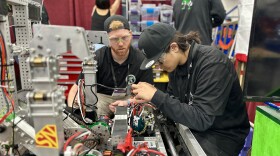The resulting images, currently on view in a show called "Unearned Intimacies" at San Diego Mesa College of Art, are large-scale, measuring 40"x48."
Iversen, who teaches photography at Cal State Fullerton and Grossmont Colleges, agreed to an interview via email.
Where did the idea for "Night Surveillance Series" come from?
This project began as an artist book titled "Quick and Dirty." The original images were black and white 4x6 inch prints on acetate. The book was an accordion design with the front and back window cut so you could actually see the photographs throughout the book and the window images. Raymond Chandler inspired the book and this work. In my book, I used some of his rich, sharp, and lyrical metaphors.
His protagonist, Philip Marlowe, along with Chandler’s storytelling, captivated me. Chandler made images appear in my mind and words move. His writings made me think about the behavior of a private eye and the daily or nightly ritual of an investigator.
What is it like to secretly observe and peer into private lives? I was curious to know if I could I do this and would I be good at it.
So, inspired by Phillip Marlow, private eye, I began constructing camera images by watching strangers in their homes at night.
"Quick and Dirty," the book, went by the wayside, remained unresolved and unpublished. One window closed and another one opened.
Walk us through your process of shooting. You decide you’re going out to shoot one night, what next?
I use my Nikon, a 35 mm SLR with (usually) a 180 mm f/2.8 lens (or longer). I put the camera on a tripod and I strap my tripod into the passenger seat of my 4x 4 with the seatbelt and a bungee cord or two. I attach a shutter release then cautiously and randomly begin my night surveillance.
I am looking for many types of indicators as to whether a location will make the cut. I have to see signs of activity in a window with a good view. Additionally, I watch for lighting considerations, indoor and out. The window frame is very important. The proximity of the window to the street is a big factor.
I always stay on public property. I find the right house and situation and I quietly lie or sit waiting for the precise moment to hit the shutter. I feel like I am waiting for strangers to enter into my frame or trap.
The process is exhilarating, frightening and makes me anxious and excited. I feel like people are watching me watch them. I am afraid to watch because we are socially conditioned to give people their privacy and not stare at them, sneak around or spy. I feel I am in violation of our social norms. It feels like I am naughty or rebellious.
When I get a good image and no one has spotted or chased me, it reinforces my focus and motivates me to go shoot another one.
These images are definitely motivated by fear. I am afraid to be seen, afraid to watch - and, at the very same moment, I determine when to suspend a strangers’ privacy.
Do you ever feel guilty?
No. More like mischievous.
Do you intend the viewers of your work to have that same stimulation?
Not the same, but when the viewer realizes he/ she is watching someone (who thinks no one is watching) lick a plate or popping pimples or using the “john,” you've got some incentive to continue to engage with the next one.
Have you ever faced legal action from this body of work?
Not yet, but I have had some close calls and had to pull work from an exhibition in order to avoid difficulties. It is bound to happen and I think I will be ready when it does. What do they - say there is no bad press, or bad press is good press?
Why are all of your images Untitled?
They are not completely untitled. The location gives them a distinctive heading. I wrestle with titles. I am quite good with them but I don't want to influence the viewer.
Well, she is licking the plate. Methodically she licked the plate for about one minute - it could have been longer! It was so uncomfortable to watch. She thought she was alone but I was there!
At that very moment, I determine when to suspend a strangers’ privacy. Also, this week when I saw this image go out on the press release, it was unsettling. The moment I saw it, I felt a twinge of edginess run through me. It stays with me in my soul. That, to me, is pretty powerful.
When considering the body of work as a whole, what are you saying about the nature of privacy in contemporary society?
We have very little privacy and it is of our own choosing. I take these photographs because people have exposed themselves to me. I observe and hit the shutter. And please realize I began the "Night Surveillance Series” many years before it was common to see cameras in phones, malls, shopping centers, streets and public places. Are we exhibitionist or voyeurs? I am compelled to make these images and to expose the voyeuristic or exhibitionist tendencies inherent in human culture. Which are you?
By nature I am not a looky-loo type. I have always had absolute respect for boundaries and privacy. At the same time, I am curious. I pay great attention to detail. These images took on a life of their own. I could not predict or arrange an outcome. I only know that each image is challenging to me on many levels.
"Unearned Intimacies," which also features the work of David Fobes and K.V. Tomney, will be on view at San Diego Mesa College through November 9th.






